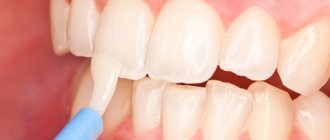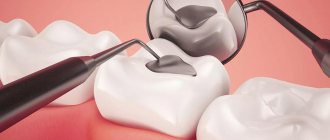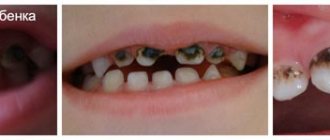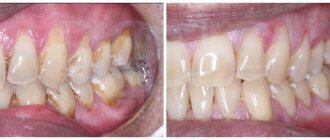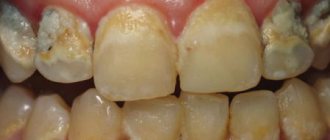Fluoridation of teeth in children is a way to strengthen enamel with the help of an element necessary for the proper development of a growing organism - fluoride. Of course, adults need fluoride no less, however, in childhood, health needs very close attention. This is explained by the rapid development of the child, in particular, the dental system. An unbalanced diet (the presence in the diet of an increased amount of carbohydrates and acids, coloring foods and drinks) and the consumption of too cold or hot water and food can weaken the enamel. Consequences: development of caries and increased sensitivity of teeth.
To prevent caries and strengthen enamel, dentists recommend fluoridation to young patients.
Fluoride is one of many components that participate in the formation of teeth starting from childhood. Together with calcium, this mineral provides strength and integrity. However, due to various factors, such as general health, nutrition, genetics, the baby’s body experiences a fluoride deficiency. The consequence is increased tooth sensitivity and the risk of developing caries.
It is very important for parents to understand that fluoridation is not a method of treating caries, but its prevention. The procedure allows you to protect baby teeth from premature destruction and protects the rudiments of future indigenous and surrounding tissues from the spread of possible carious infection.
An argument against fluoridation is an excess of the mineral in the child’s body. A disease such as fluorosis, as well as problems with the thyroid gland, occur precisely because of the oversaturation of the body with fluoride. An experienced pediatric specialist will not allow an unnecessary procedure to be prescribed.
Why is dental fluoridation important for children in St. Petersburg?
The relevance of the coating procedure with a fluorine-containing substance is explained by the fact that the current environmental situation leaves much to be desired. It is not always possible to find truly natural food products with optimal content of nutrients, in particular fluoride. Fluoridation at an early age (for medical reasons) will help avoid problems with teeth during the period of growing up and the formation of the dental system. Fluoride-containing preparations will saturate your teeth with fluoride in the required amount and keep them healthy.
Procedure technique
Deep fluoridation is not a complicated procedure. However, the final result of treatment depends on the correctness of its implementation. It is carried out in several stages:
- At the first stage, the dentist thoroughly cleans the surfaces of children's teeth from accumulated plaque and tartar. This is done using special tools and brushes that ensure maximum cleanliness.
- A stream of warm air dries the enamel surface. This is necessary for the closest contact of the enamel with the remineralizing liquid.
- A sealing liquid that contains fluoride ions is applied to the tooth. After which re-drying is carried out.
- A swab soaked in a solution of copper and calcium hydroxide is used to treat the tooth from all sides. In this case, a reaction occurs in the formation of calcium fluoride crystals inside the dentinal tubules, which strengthen the enamel tissue.
Indications
The enamel of baby teeth does not contain enough minerals to withstand the aggressive effects of microbes. The required amount of minerals accumulates after a couple of years. During this time, teeth require mineral replenishment from the outside, which is fluoridation. Without appropriate preventive measures, there is a risk of developing caries.
Note that this is useful not only for young patients, but also for teenagers, who need it no less. The reasons are as follows: active growth, hormonal changes and other processes of adolescence.
Since the enamel of permanent teeth in young children remains very sensitive for a long time, and the susceptibility to caries is many times higher than in adults, one of the methods of disease prevention is coating with a fluoride-containing substance - fluoride varnish.
Fluoridation of a child's teeth allows you to saturate them with the necessary amount of fluoride and maintain a healthy smile for many years.
Orthodontic treatment of a child is also indicated. Installing braces is fraught with mechanical damage to tooth enamel and the development of caries. To avoid such troubles, the orthodontist may recommend treating the surface of the child’s teeth with fluoride varnish before installing metal plates.
Purpose and usefulness of fluoridation
The goal of fluoridation is to restore a healthy balance of minerals in the tissues of baby teeth. Thanks to the saturation of the microelement, the enamel of children's teeth becomes more resistant to the action of pathogens and acquires a certain immunity to the influence of acidic environments.
The fluoridation procedure allows you to stop tooth decay, as well as prevent the spread of carious lesions to healthy teeth. Caries is a disease whose danger cannot be ignored: it can cause premature loss of baby teeth, which in turn can lead to the development of malocclusion. After saturating the enamel with fluoride, its excessive sensitivity also decreases.
Methods
Superficial fluoridation of teeth in children
The process involves applying a special gel to their surface. This method is used provided that the child’s teeth are healthy. It is most often prescribed to children with baby teeth. It is recommended to carry out the procedure once every six months along with professional oral hygiene.
Deep fluoridation of teeth in children
Recommended after completion of caries treatment. Before directly applying fluoride varnish, the little patient is hygienically cleaned of soft plaque and tartar, then treated with a substance containing fluoride, calcium and magnesium. The effect of deep fluoridation lasts longer than superficial fluoridation due to the deep penetration of strengthening minerals.
How to replace silvering of teeth?
Not all parents want to undergo this procedure. Are there any analogues if no other treatment is currently possible?
Remineralization therapy for caries
The goal of therapy is to saturate the affected areas with calcium. There are special gels that you can use to treat your teeth at the dentist or at home yourself. The procedure will only have an effect if the teeth are kept clean. If plaque or stone is present, there is no point in holding the event.
Remineralizing therapy is carried out:
- at the initial stage of caries;
- to prevent the formation of carious lesions.
There is nothing particularly complicated in this process, but it is better to consult a dentist, who, before applying the gel, will brush your teeth with a special brush with a paste applied to it, as a result of which the penetration of calcium into the dental tissue will increase. In addition, the doctor can use more concentrated drugs, which will benefit the child.
Therapeutic measures are carried out until the chalky spots disappear, which is individual in each case under consideration, so it is not possible to talk about the duration of the course.
The remineralizing gel, available in different fruit flavors, contains a substance that normalizes acidity and calcium glycerophosphate.
In addition to the gel, it is recommended to use a paste with amino fluoride, which will allow more calcium to be fixed in the enamel.
If caries affects dentin, then such therapy is useless. With average caries, the child is recommended to have either a filling or silvering.
Fluoridation
The procedure saturates the enamel with fluoride, which reduces calcium leaching. Deep fluoridation is justified even for superficial caries, when the white spot stage has already passed, since fluoride, penetrating into the enamel, destroys microorganisms that cause caries.
The higher the fluorine concentration used, the more effective the fluoridation procedure becomes. According to statistics, enamel strengthening occurs in more than 80% of patients who have undergone this operation.
Fluoridation is indicated:
- with white spots on the enamel;
- for caries that does not extend beyond the boundaries of the enamel;
- to prevent the occurrence of new carious lesions.
Fluoridation is a procedure that should only be performed by a qualified physician due to the very high dosages of this substance.
Based on the above, the following conclusions can be drawn:
- For white spots on teeth, it is recommended to carry out remineralization therapy, which in combination with fluoridation will have the most beneficial effect. Silvering is not contraindicated, although it will only be a temporary measure.
- For caries located within the enamel, deep fluoridation is indicated. Silver plating is allowed.
- For moderate caries, the best option would be dental filling. You can do silver plating, which will delay pulpitis, but there is a risk of burning the pulp.
Stages
- Cleaning the surface of teeth from soft plaque and tartar;
- Drying – the surface of the teeth must be dried as much as possible for high-quality fluoride varnish coating;
- Applying a composition with fluorides, magnesium and copper salts using a special brush or a sterile cotton ball;
- Repeated drying for 5-7 minutes naturally;
- Treatment with a composition containing calcium hydroxide.
The formed durable film on tooth enamel, consisting of fluoride ions, is resistant to drinks, food, hygiene procedures, does not fade or deteriorate over time.
What is enamel fluoridation
This is a procedure for saturating the enamel layer with fluoride ions and other minerals. The density of the enamel increases. It protects teeth from the effects of acids and the proliferation of microorganisms in the oral cavity. The procedure is safe and painless.
The essence of the procedure
Due to the low content of calcium and fluoride in the enamel, tooth tissue (dentin and enamel) is destroyed. As a result, they are damaged by bacteria that cause caries. Due to the opening of the dentinal tubules, sensitivity to hot and cold, sweet and sour increases. The purpose of the application is to apply remineralizing compounds to the enamel. As a result of fluoridation, microcrystals of this element are embedded in the dentin tubules and close them. This reduces tooth sensitivity and prevents caries. The procedure can not only prevent the development of the disease, but also slow it down if tissue damage has begun. Fluoride coating prevents caries from spreading in the mouth.
Expert opinion of RAIDEN specialists
The fluoridation procedure is useful for the teeth of young patients, subject to indications for its implementation and taking into account contraindications. Fluoride is certainly useful for the formation of a growing organism. Its deficiency during the formation of the dental system can affect not only the health of the teeth, but also the entire body as a whole. Excess is also harmful. Therefore, the correct dosage of fluoride varnish during the procedure is an important point. Fluoridation “within reasonable limits” is a means of avoiding more complex, expensive and painful treatment. It is better to prevent any disease than to treat it. Prices for dental fluoridation depend on the amount of work.
In what cases will fluoridation help?
Additionally, nutrition will not be superfluous for your teeth; caries prevention can be carried out without any indication. Fluoridation is especially useful in such cases:
- In complex treatment of multiple caries
- After teeth whitening
- For enamel hypersensitivity
- After treatment with braces
- Every trimester of pregnancy
The procedure for saturating tooth enamel with fluoride is carried out in different ways. The method is selected depending on the condition of your teeth and the characteristics of your body.
When is fluoridation contraindicated?
If your doctor recommends that you undergo fluoridation of your teeth with fluoride varnish or another preparation applied to the surface of the tooth, this means that you could, if you tried, avoid this. More precisely, this is how it should be, but unfortunately, many dentists themselves do not understand this and recommend fluoridation to everyone indiscriminately. Do not rush to agree if you know for sure that you are using fluoridated water or (adequately) brushing your teeth with fluoridated toothpaste. Another criterion for refusing professional fluoridation (i.e., performed by a doctor) is the absence of new caries over the past year. If more than 12 months have passed since the last cavity discovered, then your dental care can be considered good and additional fluoridation can be ignored.
Advantages
The fluoridation procedure for children's teeth has replaced the previously common silver plating. This technique has a number of undoubted advantages that make it optimal for use in childhood:
- A significant increase in the strength of enamel tissues, which helps to effectively combat the manifestations of caries.
- There is no need to repeat the dental treatment frequently. To achieve the desired effect, it is enough to carry out fluoridation 1-2 times a year.
- There is no change in the shade of the enamel, which does not cause cosmetic discomfort to the child.
- Fluoridation can be used even in advanced stages of caries. In such cases, the procedure is carried out before installing a permanent filling.
- Reducing the sensitivity of teeth to high or low temperatures.
It is believed that the procedure does not cause harm even when performed on the youngest patients. At what age the dentist decides to carry out fluoridation, but most often it is recommended for children over two years old, since from this age the child can calmly sit in a chair at a doctor’s appointment.
«
